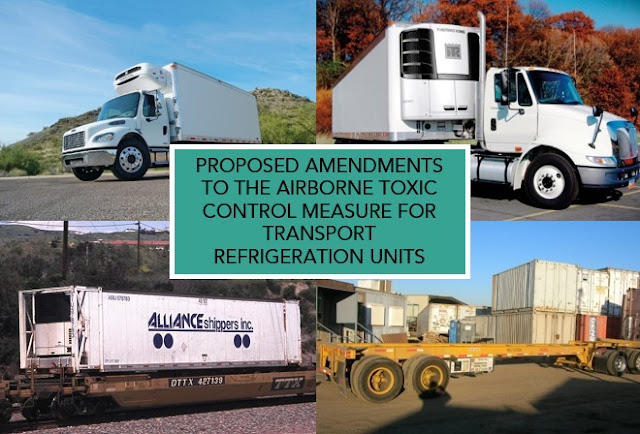Proposed Amendments to the Airborne Toxic Control Measure for Transport Refrigeration Units
California communities have expressed concern
regarding transport refrigeration units (TRU) and TRU activity. CARB staff are
proposing new requirements to achieve additional emission and health risk
reductions from TRUs. CARB staff will be presenting to the Board, for
consideration, proposed amendments to the existing Airborne Toxic Control
Measure for TRUs on September 23, 2021. The factsheet provided below summarizes
the proposed amendments and other important background information.
Proposed Amendments to the Airborne Toxic Control Measure for In-Use Diesel-Fueled Transport Refrigeration Units (TRU) and TRU Generator Sets, and Facilities Where TRUs Operate
The California
Air Resources Board (CARB) adopted the Airborne Toxic Control Measure (ATCM)
for In-Use Diesel-Fueled TRUs and TRU
Generator Sets, and Facilities Where TRUs Operate in 2004 (and amended it in 2010 and 2011) to reduce diesel PM
emissions and resulting health risk from diesel-powered TRUs and TRU generator sets. Despite the progress made,
the emission reductions achieved under the TRU ATCM are not sufficient to help meet the State’s
multiple public health, air quality, and climate goals. Staff are proposing amendments to the TRU ATCM (Proposed
Amendments) to achieve additional emission reductions from diesel-powered TRUs and increase the use
of zero-emission (ZE) technology. The Proposed Amendments are needed to help meet these complementary
goals, as well as the directive of Executive Order (EO) N-79-20, which set a goal for 100 percent ZE off-road vehicles and equipment by 2035.
Purpose of the Proposed
Amendments
- Expand public health and environmental benefits by increasing the use of ZE technology.
- Provide PM2.5 and NOx emission reductions to help attain regional and federal air quality standards.
- Provide GHG emission reductions to help meet the State’s GHG targets and climate goals.
- Address growth in emissions from trailer TRUs, domestic shipping container (DSC) TRUs, railcar TRUs, and TRU generator sets with less than 25 horsepower engines.
- Newly-manufactured truck TRUs, trailer TRUs, and DSC TRUs shall use refrigerant with a global warming potential (GWP) less than or equal to 2,200, or no refrigerant at all.
- Model year (MY) 2023 and newer trailer TRU, DSC TRU, railcar TRU, and TRU generator set engines shall meet a PM emission standard of 0.02 grams per brake horsepower hour or lower (aligns with the United States Environmental Protection Agency Tier 4 final off-road PM emission standard for 25-50 horsepower engines).
Beginning December 31, 2023:
- Owners of refrigerated WHDCs with a building size of 20,000 square feet or greater, grocery stores with a building size of 15,000 square feet or greater, seaport facilities, and intermodal railyards (applicable facilities) shall register the facility with CARB, pay fees every three years, and report all TRUs that operate at their facility to CARB quarterly, or alternatively attest that only compliant TRUs operate at their facility.
- TRU owners shall report all TRUs (including out-of-state based) that operate in California to CARB.
- TRU owners shall pay TRU operating fees and affix CARB compliance labels to their TRU every three years, for each TRU operated in California. Collected fees will be used to cover CARB’s reasonable costs associated with the certification, audit, and compliance of TRUs, as allowed by Senate Bill 854.
- TRU owners shall turnover at least 15 percent of their truck TRU fleet (defined as truck TRUs operating in California) to ZE technology each year (for seven years). All truck TRUs operating in California shall be ZE by December 31, 2029.
Cost Impacts
- Estimated avoided statewide adverse health outcomes from 2022 to 2034 are valued at $1.75 billion.
- Total net cost of the Proposed Amendments from 2022 to 2034 is estimated to be $1.04 billion.
- If the total net cost of the Proposed Amendments is fully passed through to consumers, the total cost per California household from 2022 to 2034 is estimated to be $78.35 with a yearly average of $6.03.
TRU Activities Impact Disadvantaged Communities
Health Analysis Shows Reduction in Potential Cancer Risk
Note: Individual resident cancer risk estimates are
based on a 30-year exposure duration using the Risk Management Policy method (95th percentile/80th percentile daily breathing rates. Fraction of time at home equals
1 for age bins <16
years and 0.73 for age bin 16-70 years.
Reducing Emissions from TRUs
•
The Proposed Amendments expand requirements to further
reduce statewide TRU emissions from 2022
to 2034 by approximately:
•
1,258 tons of PM2.5
•
3,515 tons of NOx
•
1.42 million metric tons of carbon dioxide
equivalents (MMTCO2e)
Available ZE Truck TRU Technology
- (A) Battery-electric truck TRUs. The diesel engine powering the compressor and fans is removed and replaced with electric motors powered by a battery pack. To recharge the battery pack after daily operations, truck TRU owners may rely on publicly accessible chargers or choose to install chargers at their home base facility. The Proposed Amendments do not include electric charging or fueling infrastructure requirements.
- (B) Cold plate truck TRU. These systems consist of a sheet metal shell, with cooling coils built inside to hold the eutectic fluid. They are similar to the gel packs used in lunch boxes and ice chests, but larger. These units would require access to electrical plugs to refreeze cold plates after daily operations.
- (C) Indirect Cryogenic truck TRU. A cryogenic fluid (liquid CO2 or liquid nitrogen) is the cooling agent, replacing the diesel engine-driven refrigeration system utilized in a conventional TRU. These units would require access to a liquid CO2 or liquid nitrogen fueling station.
Next Steps
·
First Board Hearing:
September 2021
·
Second Board Hearing:
First quarter of 2022
·
Anticipated effective date of Proposed
Amendments: October 2022
·
In response to EO N-79-20, staff plan to conduct
a technology assessment to inform the development of a second rulemaking to transition trailer TRUs and the
remaining TRU categories to ZE technology for
Board consideration in 2024.
More Information: https://ww2.arb.ca.gov/our-work/programs/transport-refrigeration-unit/new-transport-refrigeration- unit-regulation






